Grey dawn light filters into the sky as I search the tree tops. I huddle against the truck, propping my elbows on its side to steady the thermal monocular in my hands. Peering through the viewfinder, the trees on the other side of the river transform from dark shapes to a tangle of glowing color: purple, magenta, oranges and yellows. But I’m looking for white — the bright white glow that indicates a group of bat pups huddled inside a tree hollow.
Seeing nothing, I hand the monocular back to bat monitor Abigail Hill. Instead, I watch the tree-tops for fluttering black shapes as the sky continues to brighten. We’re watching a known roost tree, in the hope that dozens of pekapeka, as the bats are known in New Zealand, will return here after their night’s hunting.
“Come on bats, go to sleep!” says Hill. Bellbirds chime in the distance as the forest awakens. Minutes pass, and we spot one bat, and then three, all circling in the general vicinity of the tree. And then a swarm appears, swirling together in a gap through the foliage. We hear a faint beep on the radio receiver, which tells us that one of our radio-tracked bats, number 92, has returned to the roost, too.
Confident we have the right spot, we jump back in the truck for a well-deserved rest. We’ll be back tonight with the harp trap to capture as many bat as we can.
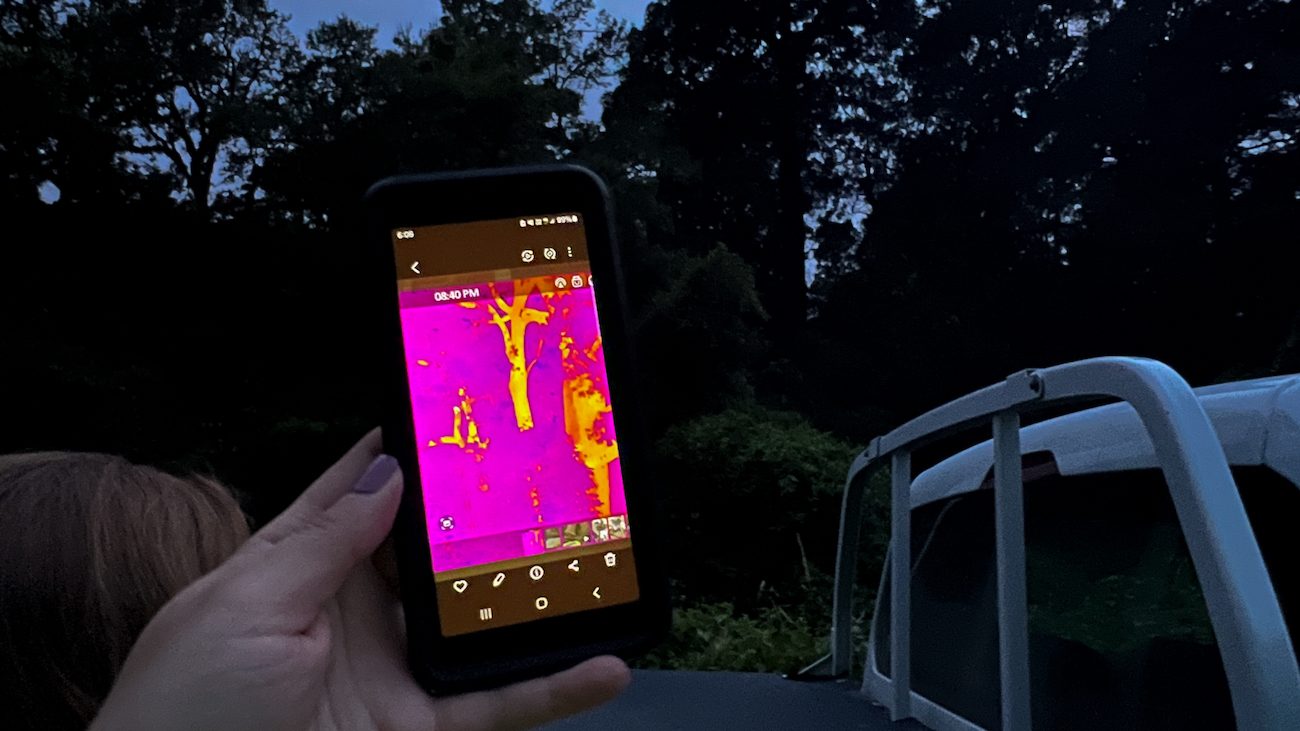
Meet New Zealand’s Only Land Mammals
New Zealand — known for its unique birdlife — is not exactly a mammal watcher’s paradise. Birders delight in seeing garrulous parrots, trundling kiwi, and colorful tūī, but the forests are conspicuously absent of native land mammals. Except, of course, for two bat species: the lesser short-tailed (pekapeka tou poto) and the long-tailed bat (pekapeka tou roa) which I’ll be chasing during my time with bat team.
Pekapeka, the Māori word for bat, refers to three species of small, insectivorous bats that were once found across both the North and South islands. One species, the greater short-tailed bat, was last sighted in the 1960s and is believed to have gone extinct after the introduction of ship rats.
The other two pekapeka still survive, but are under threat from the plethora of other introduced mammalian predators that arrived with Europeans in the 1800s, including ship rats, Norway rats, cats, stoats, ferrets, weasels, and possums. Most of these predators are capable of climbing trees, where they can find and kill long-tailed bats. Pekapeka are especially vulnerable during the breeding season, when young pups are dependent on their mothers, and during winter, when bats survive the cold temperatures by entering a state of torpor.
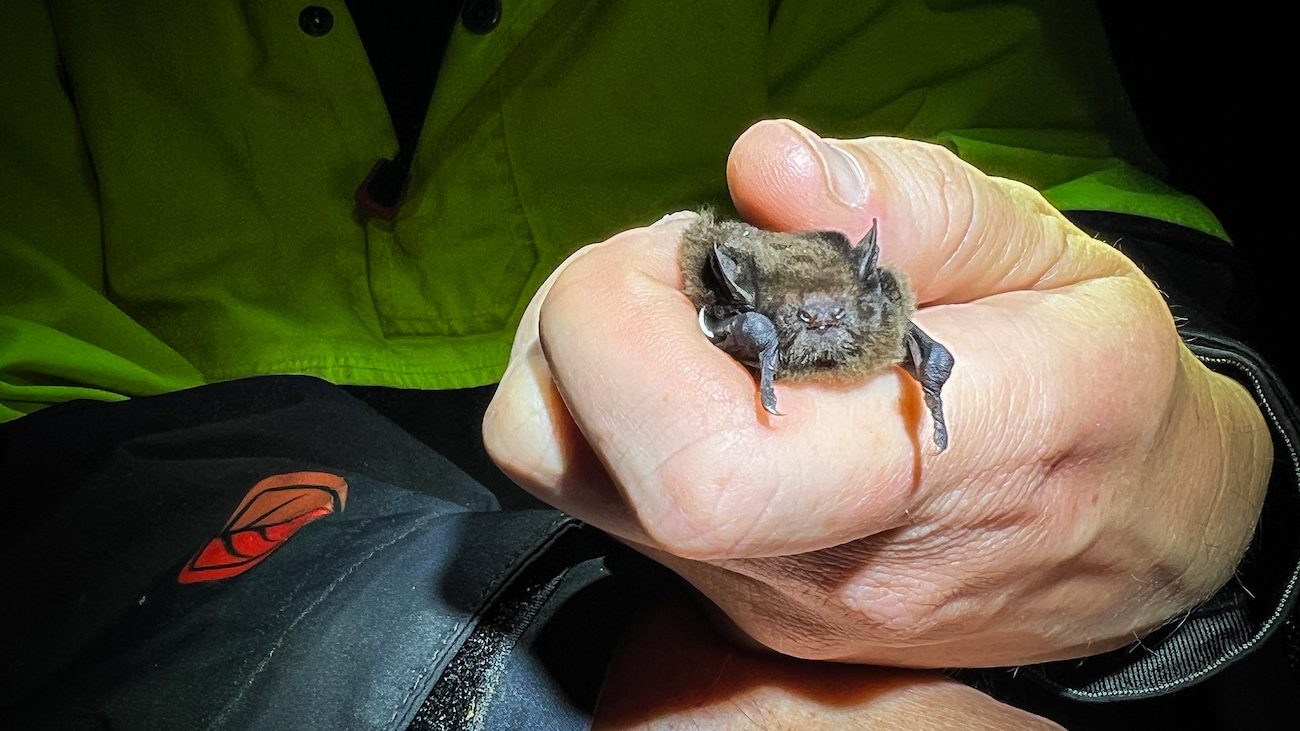
Short-tailed bats are also vulnerable when they hunt, because they’re the only bat species that forage on the ground. They use their folded wings as ‘front limbs’ to crawl across the forest floor, searching for insects, fruit, and nectar.
Long-tailed bats are critically endangered, while the lesser short-tailed bat is considered vulnerable. In addition to predators, both species are threatened by habitat loss and fragmentation. Significant amounts of New Zealand’s forests have been cleared since European settlement to make way for agriculture, forestry, and sheep and cow pasture. Scientists fear that, without intervention, long-tailed bats could be extinct on the mainland within 50 years.
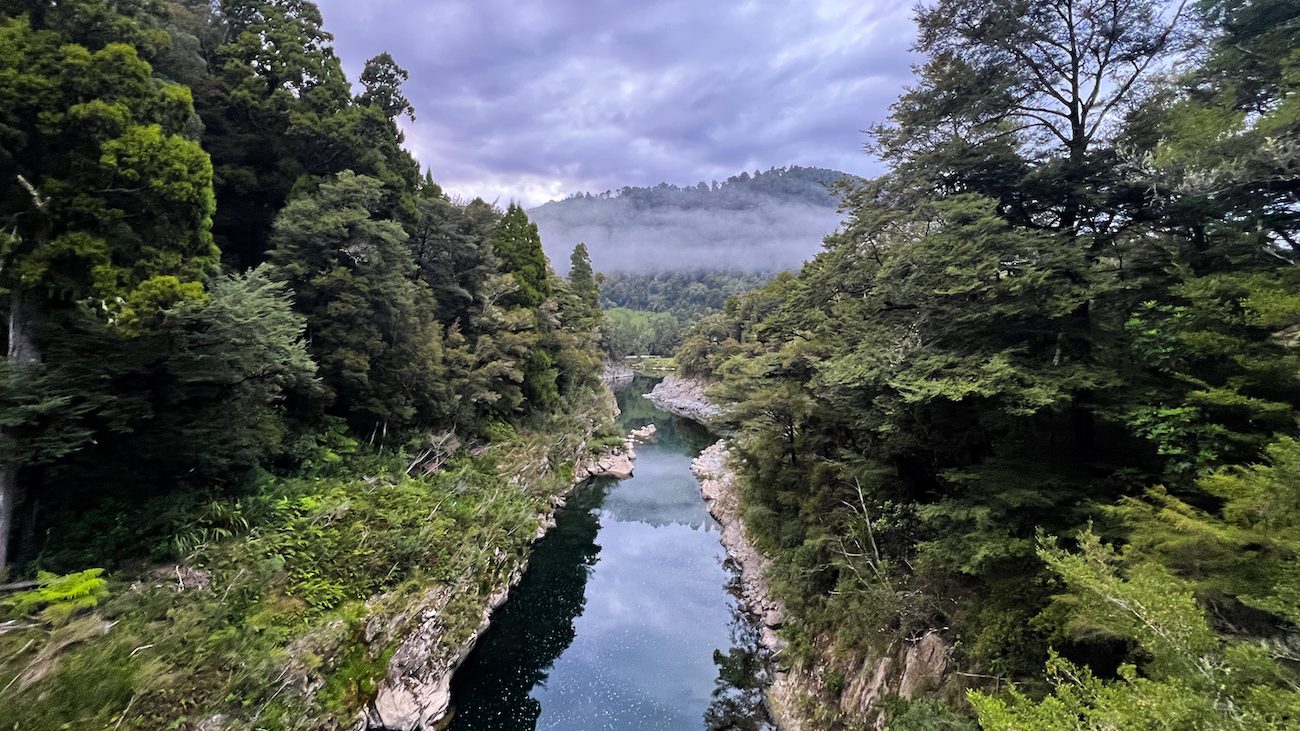
Pelorus Bridge Reserve, along with three nature reserves in the Rai Valley, are home to one of the last remaining populations of long-tailed bats in this region of the South Island. Conservationists originally thought they’d been lost from this area, too, until Forest & Bird staffer Debs Martin noticed the small silhouettes of bats flying overhead while camping at Pelorus Bridge. (Martin now works for The Nature Conservancy, supporting conservation efforts in the region.)
After the rediscovery, national organization Forest & Bird established a predator control program at Pelorus Bridge, with breeding season monitoring starting a few years later. A partnership with the Te Hoiere Project helped restore bat habitat through noxious weed control and native tree planting. Now, the focus is on sustaining the predator trapping efforts at Carluke and Ronga Reserves, which were initiated through a collaboration with Ngāti Kuia, the local Māori tribal group.
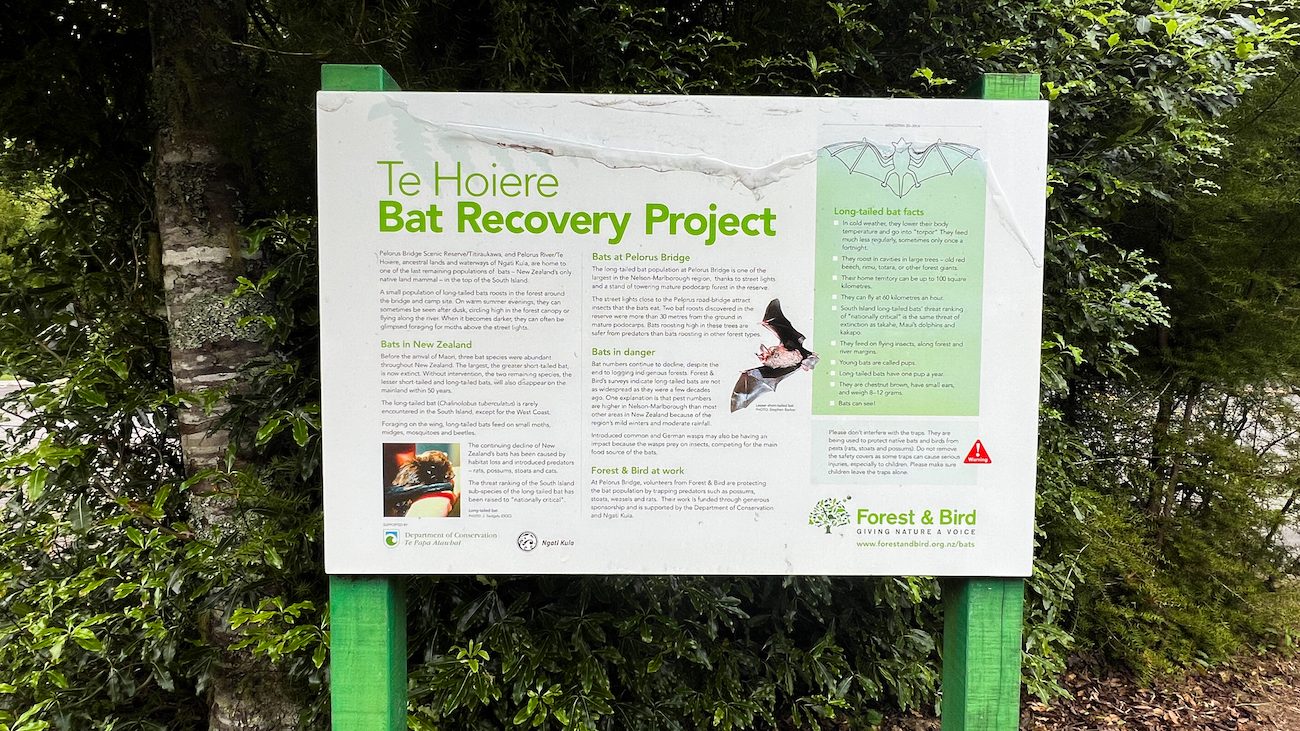
Searching for Pekapeka
I arrived in the Rai Valley the previous afternoon and met the members of the bat crew as they awoke from their morning’s sleep: team lead Grant Maslowski, Abigail Hill, Jen Waite, and Nick Eade. (Fieldwork can run long into the night, and so everyone sleeps when they can during the day.)
After an early dinner, Eade and I set out for a roost watch at Pelorus Bridge. She located this bat earlier in the morning, by following signals from the radio transmitter the team affixed to the animal’s back a few weeks ago. It’s a strategy they use throughout the 6-week monitoring season.
The local bat population is scattered across dozens, if not hundreds of roost sites throughout the valley. Each morning, they take shelter deep in a hollow branch or trunk, often podocarpus species like mataī and rimu. Some roosts are a mere meter off the ground, others might be 25 meters high in the canopy. Some contain a single bat, or maybe two, others might house more than two dozen. And some roosts remain popular throughout the breeding season, others are full one day and empty the next. This means that monitoring the bat population is a constant game of hide and seek.
That’s where the radio transmitters come in handy. With a bit of luck — and lots of trekking and driving — the team can track the bats back to their roosts each morning, revealing where the bats are hiding and where might be a good place to set up the harp trap. Tonight, our goal is to return to the roost where bat #86 is resting, and to see if she’s alone or with a larger colony.
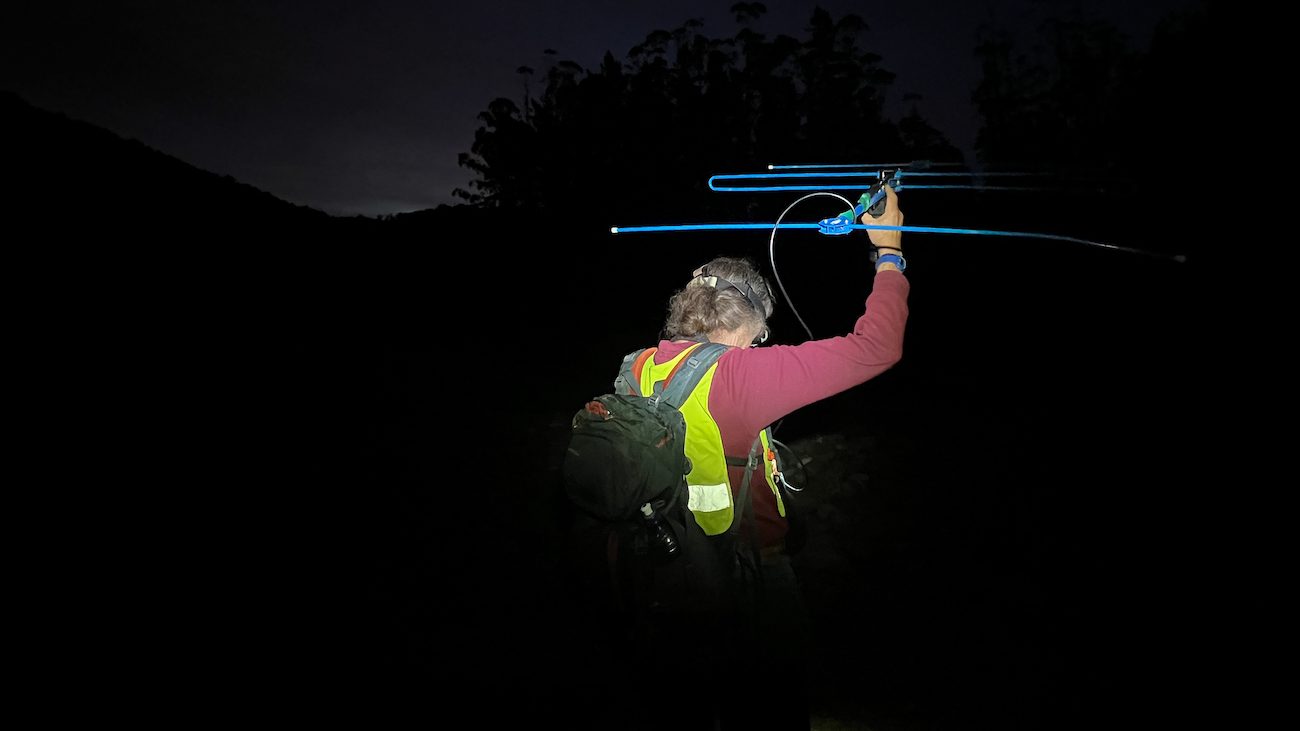
We arrive just before dusk. The roost tree isn’t far from the Pelorus Bridge campground, a popular destination among kiwi people, and we pass dozens of families enjoying a barbecue and a swim on this long holiday weekend. Just before we duck into the forest, two curious kids call out: “Hey, are you the bat lady?” We stop, laughing, and Eade replies that yes, we are indeed here for the bats. “Oh my god, cool!” The kids shout, piling on with questions about the large antenna Eade is carrying (the radio transmitter) and why we’re here.
It’s only a short walk from the campground to the roost tree. It’s darker in the forest, the day’s last light shaded by massive mataī and old-growth beech trees. Beneath them, primeval-looking tree ferns stretch their fronds over mossy logs. This reserve protects one of the last remnants of old-growth lowland forest in the valley. On the drive here, almost every surrounding hillside was covered in pines, all plantation timber that will eventually be clear-cut and replanted with seedlings.
Eade and I take up our vigil at the base of the tree, eyes squinting for any sign of departing bats. We’re silent, save for the beep, beep of the radio transmitter, steady as a heartbeat, that tells us the bat is still here. After 30 minutes of waiting, we see a small, dark silhouette flutter out from high in the canopy. The beeping fades out as the bat flies off towards the river. “I think it might be a one-bat wonder,” says Eade, peering up into the tree. She’s right. No more bats tonight, at least not from this tree.
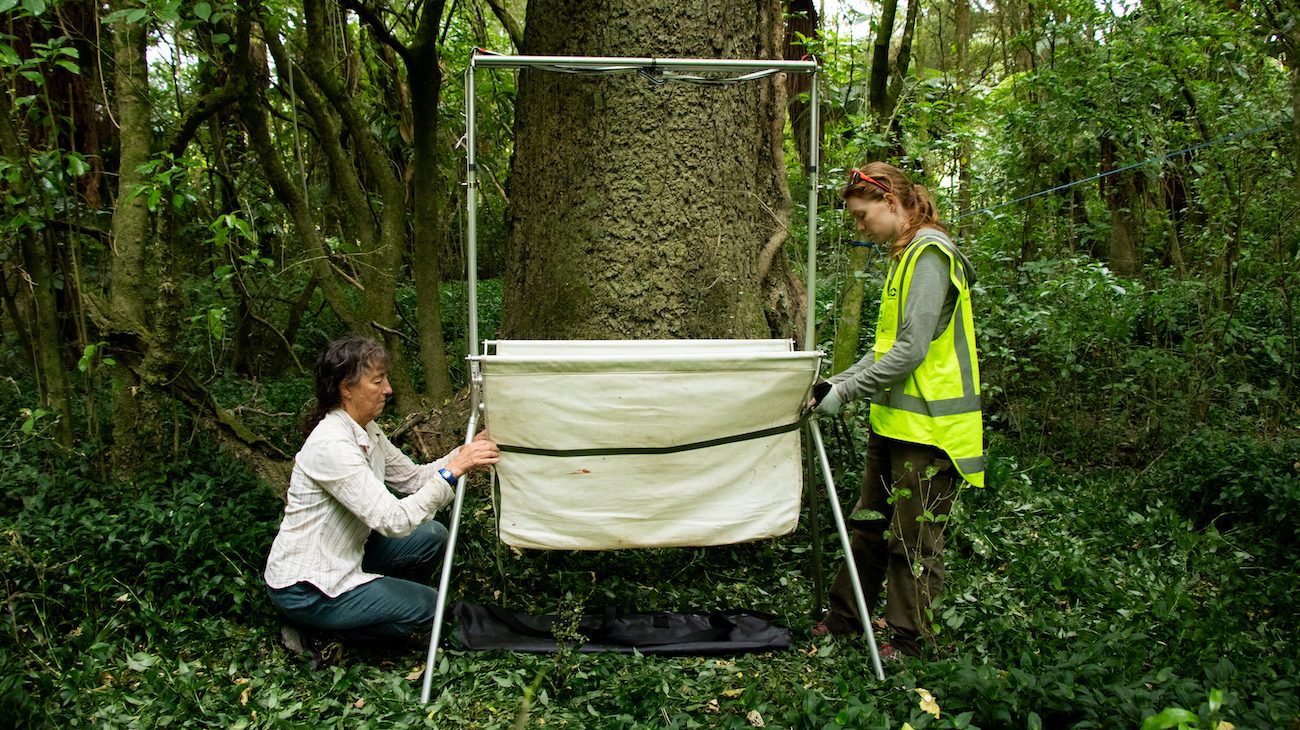
Fishing for Tree Limbs
The real work begins the following afternoon. After an early lunch we drive over to the Bulford Reserve, where we’ll attempt to trap the roost we located via the thermal scanner earlier this morning. Maslowski runs us through our gear list: Rope? Check. Helmet? Check. More rope? Check. Slingshot? Fishing rod and sinker? Check.
Hill hands me the fishing rod, and before I have time to wonder what we’re going to use it for, she and the rest of the group striding off into the paddock. We follow a ramshackle fence along the river, wading through introduced blackberry and cow parsley until we find an easy place to slide down the bank and ford the river. Wet to the knees, we scramble up the opposite slope and then cut a path through the forest. Maslowski motions for silence as we near the roost tree. From now on we’ll communicate in whispers and a makeshift sign language, so as not to disturb the bats.
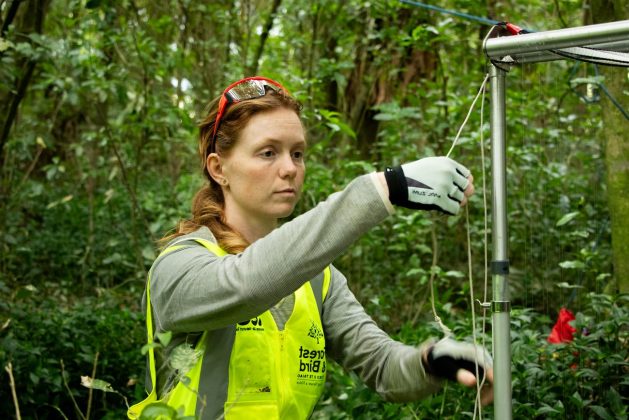
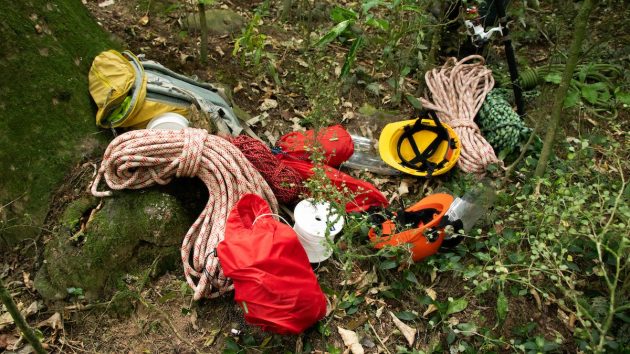

After a good half-hour of strategizing, Maslowski has a plan for how to best position the trap against the long, narrow hollow entrance. The first step is to hang the climbing ropes from nearby tree limbs. And this is where the fishing rod comes in: instead of a hook, there’s an inch-wide metal sinker affixed to the end of the line. Eade holds the reel while Maslowski fits the sinker in the slingshot and takes aim for the treetops.
“So this is the dangerous part,” he says, eyeing his shot. “Just hide behind that tree till you hear the sinker hit the ground.” (Apparently, people have lost teeth). Peering around a nearby trunk, I watch him take aim and release the sling. The sinker whizzes upward into the canopy and then falls back to earth with a thunk.

We have several ropes to position, both to raise the harp trap and to lever low-hanging branches out of the way. It takes seven attempts before Maslowski positions the first exactly where he wants it, which Hill informs me is expert-level speed. It’s slow going, but highly entertaining to watch.
As the final ropes are threaded into place, Hill and Eade start setting up the harp trap. The device is named for the ultra-fine strands of plastic, similar to fishing line, that are invisible to bats and help funnel them into the trap. As the bats flutter out of the hollow, they hit the harp strings and slide down into the canvas pouch below.
The whole thing clips together in a few minutes. Maslowski and Hill attach ropes to either side of the frame, and then gently raise it up into the canopy. The hours of strategizing angles and getting the rope just right paid off; the trap stops in prime position, right in front of the hollow entrance.

Bags of Bats
We return after dusk, after a hasty dinner of leftovers. Headlamps shining, we tramp back along the field, across the river, and through the bush to the tree. Working quickly and quietly, the team lowers the harp trap back to the ground, and we have our first peek inside. A handful of small brown fluff-balls huddle together in the corners. We have bats!
Now the real work begins. We put on face masks and then the team begins extracting the bats from the harp trap one by one. Each is placed inside a soft cloth bag, and soon a little pile grows on the forest floor. Once the trap is empty, it’s time to collect the data.
The first step is weighing the bat, still in its cloth bag. Then we collect data on if it’s an adult or juvenile, and male or female. For the female bats, we can also determine if they’re nursing a pup back in the roost, based on the appearance of their nipples.
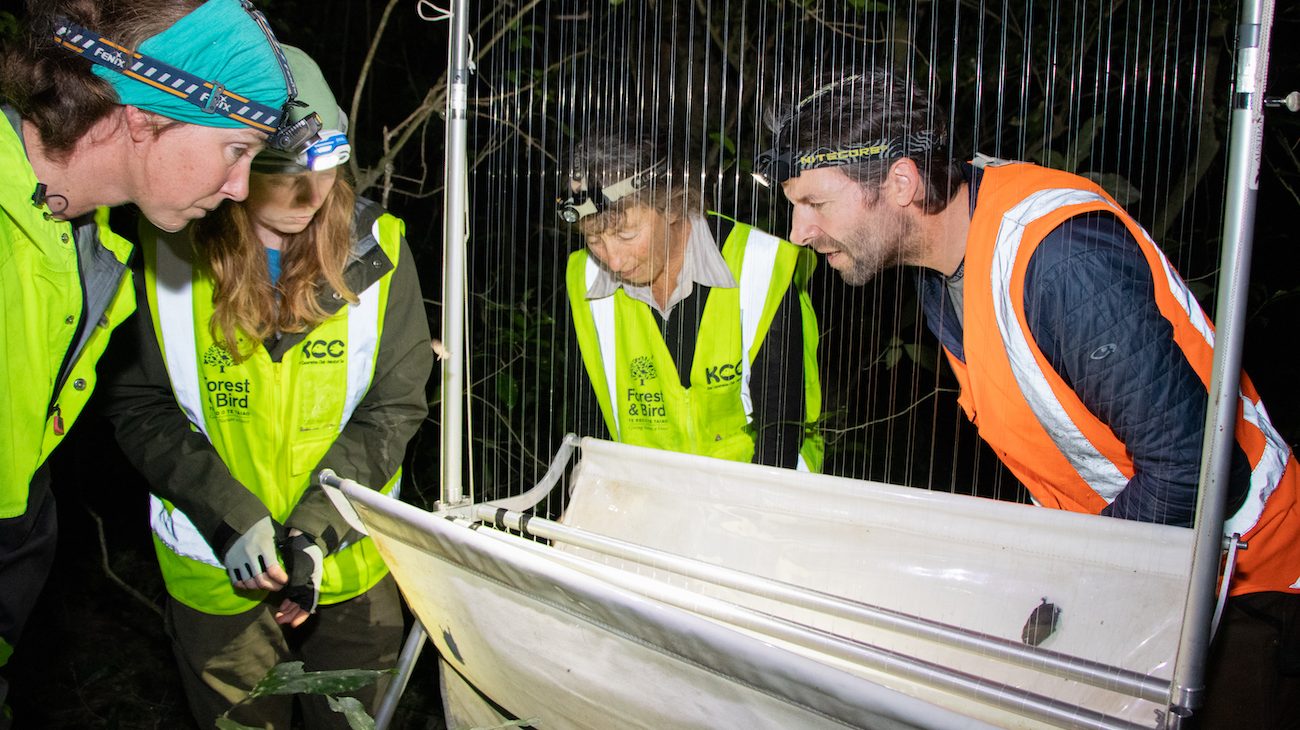
Once bat pups are large enough, their mothers will leave them behind in the roost as they travel up to 20 kilometers each night to feed. “This season we’ve learned that they can breed at one year of age,” explains Maslowski, “because we recaptured females that we caught last year as juveniles, and this year they’re lactating.”
The last step is to check and record the band number for previously caught bats. If it’s a new individual, then we’ll affix a bat band, which looks like a tiny metal bracelet, to the animal’s wing. These 11 individuals tip the total bat count fror the season to more than 200 captures of at least 120 individuals.
“Getting a high rate of recaptures is the goal,” says Maslowski, “because they will tell us if the bat population is increasing or decreasing, and if the predator control is sufficient to get the population stabilized and on an upward trajectory.”
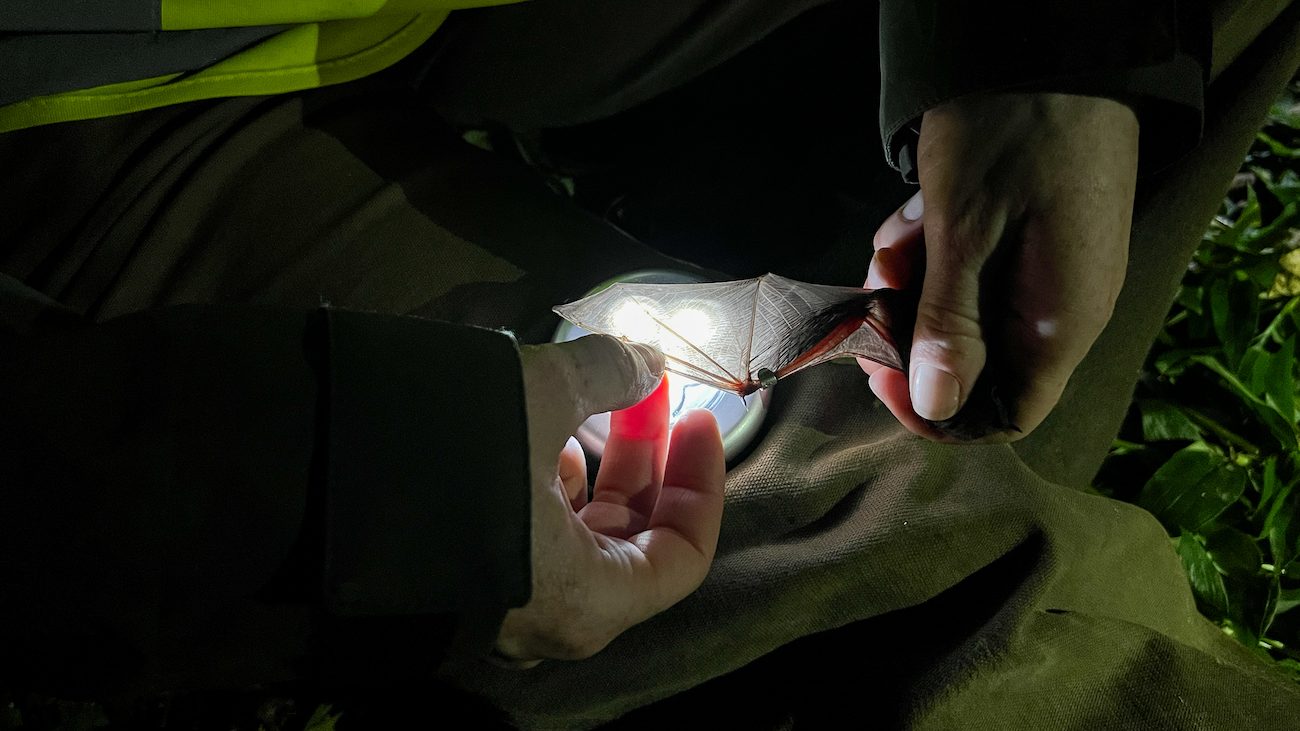
Keeping Predators at Bay
Intensive predator control is underway in two of the Rai Valley’s reserves — Carluke and Ronga — as well as in Pelorus Bridge Reserve, which sits at the southern end of the valley. “The main thing we’re targeting is rats, but we’re also hoping to catch any of the three species of mustelids (ferrets, stoats, and weasels) and also brush-tailed possums,” explains Hill. As a predator control officer, she runs Forest & Bird’s network of more than 220 traps at Carluke and at Ronga Reserves, while the Pelorus trapping grid is run by a dedicated volunteer network.
Managing trap lines is hard and dirty work, but Hill says it’s essential to ensuring the bat’s survival. “We don’t actually have a lot of data on predation pressures for pekapeka,” says continues. We know predators are a problem, and we know that trapping can reduce the number of predators. But exactly how intense should your trapping efforts be? And should that effort change throughout the year, based on when bats come together to breed in summer? Those things are less certain, so the data she collects while trapping will help find the answers.
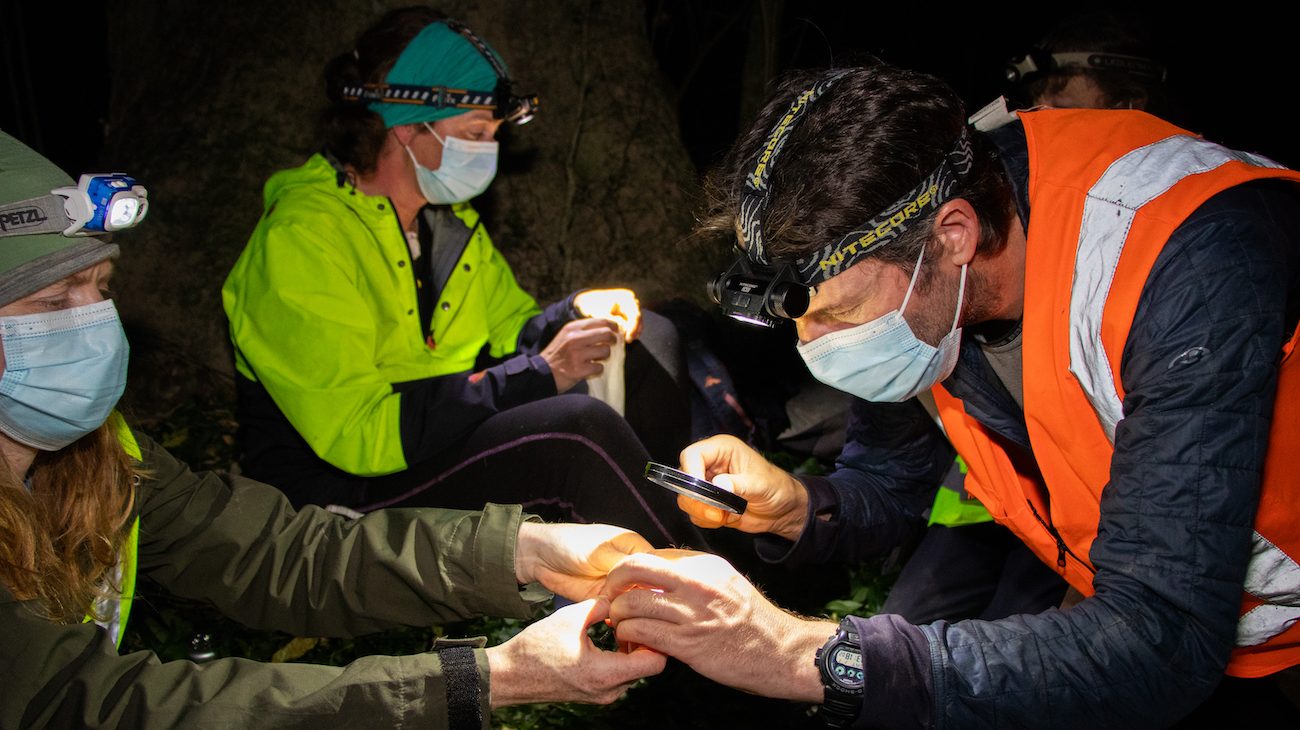
“These reserves are some of the last remaining lowland podocarp forest in the area,” adds Hill, and the predator trapping will benefit other species living here, including fantails (pīwakawaka), bellbird (korimako), wood pigeon (kererū), and powelliphanta, a giant carnivorous land snail.
It’s a lot of work for a little bat, but it’s worth it. “Bats tend to be a bit forgotten. They’re not the charismatic megafauna that people typically love,” says Hill, “but bats provide such an important ecosystem function by eating insects.” And, as New Zealand’s only land mammals, pekapeka are even more precious.
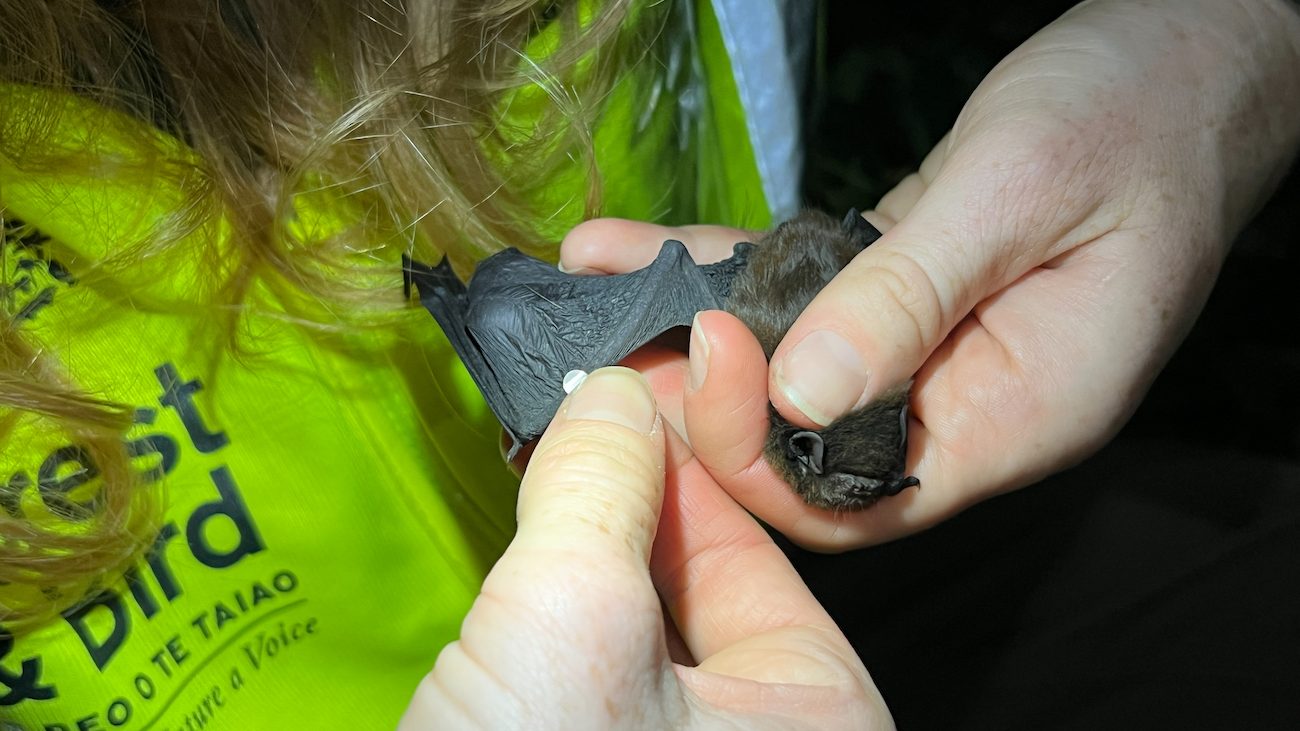
It doesn’t take long for the team to work through our little pile of bats. As Maslowski finishes collecting data on the last pekapeka, Hill asks if I’d like to help release the little bat back into the night. She places the small, squirming bat in my hand, positioning my fingers over its hind-legs and wings. I take a moment to appreciate this tiny, tenacious animal: fur soft as featherdown, twitching pug-nose, and small bright eyes.
I hold my hand up high and unfold my fingers. The little pekapeka perches there for a moment, and then with a wiggle and flap it flies off into the night, gliding silently out of the beam of my head lamp.
The Te Hoiere Bat Recovery Project, supported by Forest & Bird, is part of the Kotahitanga mō te Taiao Alliance. The alliance is a collaboration of Iwi (Māori Indigenous tribes) and government agencies at the top of New Zealand’s South Island that aims to restore and enhance nature across 3.4 million hectares of land and sea. The Nature Conservancy supports the alliance by providing facilitation, funding, science, and global expertise.




Join the Discussion